|
|
|
| Published
on 21
Jul
2012 |
All rights reserved.
|
|
|

|
The 1997 A-class was a breakthrough to
Mercedes-Benz. Not only it was the company's first front-wheel drive
small car, it also introduced a revolutionary "sandwich" structure
which enabled a spacious interior out of a very compact body shell.
Unfortunately, like many innovative ideas, the sandwich structure fell
victim to its uniqueness. It demanded bespoke engines, gearboxes,
suspensions and almost everything so that component sharing with other
models was virtually impossible. As a result, the first two generations
of A-class were more costly to build than conventional family hatches
thus they were hardly profitable. For the third generation, Mercedes
finally ditches the sandwich structure and switches to conventional FF
architecture. Hopefully this will allow more models to be built upon
it, such as B-class, CLC, GLC and even an Infiniti hatchback through
the joint-venture agreement with Renault-Nissan group. Much larger
economy of scale should drive down the cost basis.
In terms of mechanical layout, the new A-class is no different to a
Volkswagen Golf or Audi A3. Its four-cylinder engine is mounted
transversely above the front axle and drives the front wheels (4matic
will be available later). The front and rear suspensions are MacPherson
struts and multi-link setup respectively. Power steering is provided by
a rack-mounted dual-pinion electric system. In other words, thoroughly
modern but nothing unconventional. However, having set its main target
at BMW 1-Series, the Mercedes design team deliberately shaped it like a
rear-wheel-drive sporty hatchback. This is implemented with unusually
long bonnet and front overhang which deliver a false impression of
longitudinal engine. Thanks to the long bonnet, the glass house looks
more rearward than it actually is, hence a cab-rearward profile like
the 1-Series. Moreover, the Mercedes design is more successful
aesthetically, looking both sportier and more stylish than the
underachieving BMW. Without knowing their contents, you might think the
A-class was the sportier one.
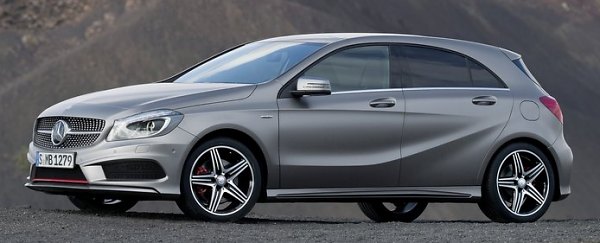
|
That is not the real case, of course. Although Mercedes
worked hard to persuade keen drivers with its optional AMG suspensions
(harder and lower than the standard setup), a very direct variable-rate
steering and wheels/tires combination as aggressive as 235/40ZR18, the
A-class is sporty up to a point. It offers excellent grip, good body
control, accurate steering and good resistance to understeer in most
circumstances, but it never stops feeling nose-led, lacking the sense
of agility you can find in BMW 125i M Sport. Moreover, with these
aggressive options the ride quality does suffers from a harshness you
won't expect on a Mercedes.
That means the regular suspension, wheels and tires are better bet.
With these the A-class is more enjoyable for everyday driving. Its ride
is pretty absorbent and quiet, although the latter is partly offset by
the intrusive wind noise from the A-pillars. Even though it does not
match 1-Series for handling, it is slightly sportier and more engaging
than the new Audi A3. Compare with the outgoing A-class, its handling
is a day-and-night difference, of course. The difference is contributed
by not only its 24 mm
lower center of gravity but also the fact that you sit 174 mm lower in
the cabin, i.e. right on the floorpan rather than the second layer of
sandwich. The new car's generous use of high/ultra-high-strength steel
(67 percent of all) and aluminum components (bonnet, rear wheel
carriers and spring links) also help.
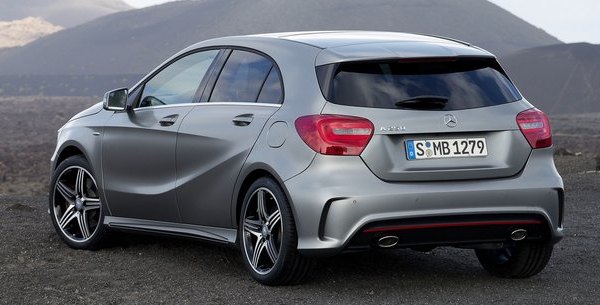
|
Apart from handling, performance and economy are also vastly
improved from the old car. While the latter employed some outdated SOHC
engines, the new car is offered with a new range of M270-series
four-cylinder petrol engines. They are really state of the art, with
all-alloy construction, DOHC 16-valves, intake variable cam phasing,
on-demand lubrication/cooling, automatic stop-start, turbocharging,
multi-spark ignition and sophisticated piezo direct injection – the
latter enables up to 4 injections per combustion, resulting in
Euro-6-compliant emission and reduced consumption. The turbocharging
employs scavenging effect to cut turbo lag (by overlapping intake and
exhaust valve opening, it lets fresh air to rush into exhaust manifold
and spool up the turbine). The entry-level engine displaces 1595 cc and
has two states of tune – A180 with 122 hp / 147 lbft and A200 with 156
hp / 184 lbft. Both achieve peak torque from a respectable 1250 to 4000
rpm. The 1.6-liter unit also introduces Mercedes' new Camtronic
variable valve lift to reduce pumping loss at part load. This results
in another 4 percent improvement in combined consumption. Both engines
emit less than 130 grams of CO2 per km.
Another member of M270 displaces 1991 cc and serves A250. It does not
have Camtronic, but it adds twin-balancer shafts at the bottom of the
block to suppress its extra vibration. The engine looks good on paper,
with 211 horsepower and a Golf GTI-beating 258 lbft of torque from
1200-4000 rpm. Unfortunately, its power delivery is a bit diesel-like,
i.e. gusty low down but lacks sparkles at the top end – it redlines at
only 6200 rpm, versus 7000 rpm on Golf GTI. The 7G-DCT dual-clutch
gearbox it partners is also nowhere as responsive as Volkswagen's DSG.
Consequently, the A250 does not feel as thrilling as its 149 mph top
speed or 0-60 mph figure of 6.3 seconds suggested. It is a fast premium
hatch rather than a true hot hatch.

|
On the diesel side, Mercedes OM651 series turbo diesel
engines have 3 variants: 2.1-liter 170 hp for A220 CDI, 1.8-liter 136
hp for A200 CDI and 1.8-liter 109 hp for A180 CDI with 7G-DCT. Worth
noting is that the A180 CDI equipped with manual gearbox is served with
Renault's 109 hp 1.5dCi engine instead, despite of a new codename
OM607. As we already know, the Renault engine is a superb one, being
frugal, refined and energetic. No wonder Mercedes is pleased to employ
it. That said, A200 CDI is the pick of the bunch with all things
considered.
All A-class models come with eye-popping fuel economy and emission
numbers. Apart from more efficient engines, the class-leading
aerodynamics also helps a lot. Regular models have a Cd of 0.27, thanks
to adjustable radiator grille shutter, underbody cladding and finlets
located next to the rear window. The sleekest A180 BlueEfficiency
Edition even achieves 0.26 with the help of partially sealled grille
and reduced ride height. Other contributors to improved economy include
taller gearing and a lazy Eco mode of the 7G-DCT gearbox.
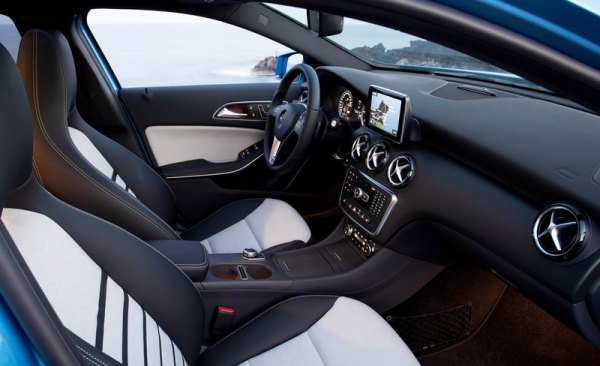
|
The interior of new A-class is not as spacious as its
predecessor's, of course. In fact, for a front-wheel-drive hatchback
running a generous 2700 mm wheelbase, the space it offers is
disappointing. It has barely enough room for four six-footers.
Visibility and sense of airiness are seriously hampered by the shallow
glass, prominent C-pillars and tapered side windows. Fortunately, the
driving position is good and the front seats are comfortable. The
dashboard, console and door panels are not exactly the same as that of
the B-class, but they obviously share a lot of components. The whole
thing looks stylish and high-quality, but touch it and you will find
some switches feel cheap and some storage compartment lids feel filmsy,
so it fails to match Audi A3, Volvo V40 and BMW 1-Series for sense of
quality. The 340-liter boot is on the small side, and its aperture is
seriously narrowed by the fixed taillights. Sadly, what used to be the
traditional strengths of A-class become its weaknesses.
Compare with the old A-class, the new car is unquestionably more
rounded, especially in performance and handling. However, in the
process of normalization it also loses its own character. Compare with
its rivals, it is not particularly good to drive. Neither is it
particularly refined, comfortable, spacious or well built. Save a good
look, there is virtually nothing let it stand out of the crowd.
Nevertheless, to many people the combination of stylish look and a
three-pointed star badge is already enough to seal a deal. Whether it
will be sold at higher volume than its predecessors remains to be seen,
but the common platform strategy should bring a brighter future to the
A-class.
|
Verdict:     |
| Published
on 22
Jul
2013 |
All rights reserved.
|
|
A45 AMG
|
|

|
As
you might have observed, AMG has overtaken BMW's M division in recent
years. Its CLK63 Black series, CLK DTM, C63, E63 and C63 Coupe Black
series all earned the highest regards
from car enthusiasts. However, can it play the same magic if it leaves
the traditional formula of V8 engine and FR chassis behind? That will
be interesting to see. So far AMG's service covers only the FR
platforms of Mercedes. As the front-wheel-drive MFA platform is getting
more and more important to Stuttgart, AMG has to expand to the Mercedes
small cars. The first act is A45 AMG.
Don't be fooled by its name, the A45 is powered by not a 4.5-liter V8
but an engine with half the cylinder count and less than half the
capacity. Codenamed M133, this turbocharged straight-four displaces
only 1991 cc, i.e. the same as A250. This might
raise many eyebrows, especially when Audi RS3 and BMW M135i employ a
2.5-liter five-cylinder turbo and a 3-liter straight-six
turbo respectively. However, the M133 answers your doubt with some
jaw-dropping
numbers: despite of its small capacity, its maximum output is 360
horsepower at 6000 rpm, whereas peak torque is equally impressive at
332 lbft, delivering from 2250 to 5000 rpm. That means its specific
output is 180.8 hp, a new record for production engines! This is
not only the most powerful 2-liter engine in the world but also the
most powerful four-cylinder engine of all (remark: forget Mitsubishi
Evo FQ400 or the like as they were not type approved). It
eclipses its Audi and BMW rivals by 20 hp and 40 hp respectively, and
trumps the same-capacity Renault Megane RS265 by nearly 100 horsepower!
Judging by stop watch, it also beats them convincingly with a 0-60 mph
time of 4.4 seconds, although all cars are capped by 155 mph. A
4.4-seconds hot hatch! Can you believe? How can AMG
achieve this?
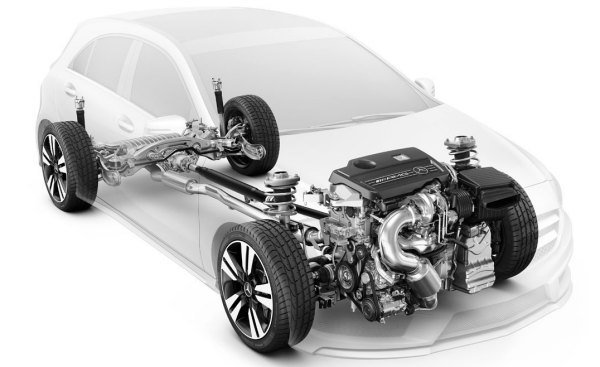
|
The M133 is derived from the A250 engine, but it is heavily reworked.
It gets a stronger sand-cast aluminum block, forged steel crankshaft
and forged pistons. A large twin-scroll turbo is employed to provide
boost pressure up to 1.8 bar, again an unheard figure for production
engines. To deal with the tremendous heat resulted from the ultra-high
boost pressure, AMG developed a 2-stage intercooler system which has an
additional cooler in the left wheel arch.
Meanwhile, cooling to the engine water circuit and transmission
lubrication oil are both handled by a heavy-duty cooling system
integrated with the transmission. Apart from hugely powerful, the
engine keeps the fuel economy advantage of four-cylinder motors,
returning 41
mpg on European combined cycle. This is partly thanks to
automatic stop-start and spray-guided direct injection.
There is no way a front-wheel-drive chassis could tame 360 horses,
therefore AMG fitted it with mandatory 4matic system. It employs a
rear-mounted Haldex electrohydraulic multi-plate clutch (like VW
4motion or Audi's Quattro on transverse-engine applications) to engage
the rear axle when the front end slips. This mean the A45 is primarily
FWD in normal driving conditions, unlike the full-time 4WD on Evo or
Impreza. The A-class' 7-speed twin-clutch gearbox is employed but
strengthened and reprogrammed by AMG. It features 3 modes (Controlled
Efficiency, Sport and Manual), in addition to double-declutching and
Race Start function. The speed-sensitive dual-pinion electric power
steering gets faster but fixed ratio (14.5:1). The reworked suspension
gets
sturdier components and sportier tuning but the dampers are left
passive. Rear subframe is now mounted rigidly to the monocoque body to
sharpen chassis response. 18-inch wheels are shod with 235/40ZR18
tires. Running within them are upgraded brakes, with ventilated and
perforated discs measuring 350 mm front and 330 mm rear. Finally, a
3-stage ESP (On, Sport or Off) completes the package. Everything looks
classy.
 |
You might find the AMG version doesn't look remarkably different from
lesser A-class
with AMG Sport kits. Considering how striking the latter looks, only
fools would ask for more differentiation. It has to be rated as the
most stylish hot hatch together with Opel Astra OPC and Renault Megane
RS, so it has a strong advantage over the ugly M135i and dull Audi S3.
On the flip side, the AMG is also the most expensive hot hatch on the
market. Priced at £38,000 before options, it makes the
£30,000 M135i looks great value and the £22,000 Ford Focus
ST like bargain of the century. But then the AMG does feel more
special and provides you with classier ingredients. After all, this is
an AMG.
Inside, the AMG has an excellent pair of Recaro bucket seats, and you
can opt for some very tasteful carbon-fiber trims on the dash and door
inserts. As in lesser A-class, the driving position and ergonomics are
good. Rearward visibility less so, while some plastics and switches
look cheap and disgraceful for a
car so pricey.

|
On the Road
Once getting it to the road, you will quickly forget about the cheap
plastics. This car is really fast! Megane RS265 and Astra OPC are a
league or two slower. Even the big-engined M135i fails to keep up with
it, no matter on straights or on mountain roads. The AMG uses its
superior power and 4-wheel traction to destroy its oppositions. Forget
the claims of 0-60 mph in 4.4 seconds, I won't be surprised if road
test results fall between 4.0 and 4.2 seconds, and 0-100 mph should be
accomplished in about 10 seconds, believe or not.
Inevitably, the high-boost 2-liter engine is not as responsive at low
rev as the BMW straight-six, but its twin-scroll turbo is not
particularly laggy either. Tractability at low rev is okay, but it
starts working like a performance engine from 2000 rpm and gets a
second lease
of life from 5000 rpm. From there to the 6500 rpm redline it really
goes mad! This top-end rush makes a big difference to the driving
experience as
it tempts you to push harder and harder just for the sake of
fun. The higher the rev, the more responsive and the smoother the
engine becomes, which is really addictive. This sensation is also
supported with a sporty exhaust note. Like AMG's 5.5-liter twin-turbo
V8, it releases pops and crackles on the overrun to remind you that
turbocharged engine is not necessarily boring to listen to.
The 7-speed twin-clutch gearbox is slightly less satisfying. It is not
as fast as DSG / S-Tronic and sometimes it may be reluctant to
downshift. However, it is already an improvement from the standard unit
on A-class. For most of the time it doesn't spoil the driving
experience.
Although the driving experience is dominated by the engine, the chassis
is not mediocre either. We are not convinced with how the regular
A-class handle and ride, but the AMG version is a lot more satisfying.
It still rides very hard compared with most hot hatches, but the
damping is very well developed so that it resists pitch and roll
brilliantly, keeping the car composed on whatever surfaces. It feels
keen and alert. Despite of the similar 4WD design, it resists
understeer much better than the Quattro-equipped Audis, proving that
chassis tuning is even more important than mechanical layout. No, it
cannot play power slide like the rear-drive M135i or 4-wheel drift like
Evo or STi, neither can it match Megane RS265 for mid-corner
adjustability, but it still steers keenly and accurately while offering
remarkable traction and grip. The 4matic allows you to exploit its
tremendous power without fear. As a result, you can push the A45 much
harder than its rivals on challenging roads. This is more than enough
to offset its less playful back end.
More interesting is, the chassis feels better the faster it goes. The
ride improves with speed. The steering, which isn't fully transparent
at lower speeds, weighs up and becomes reassuring. The massive brakes
give you full confidence to push the car as hard as you can. This is a
car born to be driven fast. In other words, a real driver's car. It
replaces Evo X to be the fastest A-to-B car today. It also trumps M135i
and RS265 for driving excitement. A new hot hatch King is born.
|
Verdict:      |
| Published
on 15
Sep
2015 |
All rights reserved.
|
|
A45 AMG 381 hp
|
|
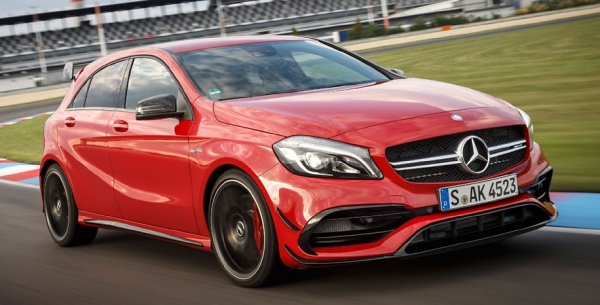
|
A45
AMG has never been short of power.
In fact, with 360 horsepower on tap it is still by far the most
powerful hot hatch in the 2.0-liter class as of today. However,
recently Audi RS3 has stolen the headline with a larger, 2.5-liter
5-cylinder engine, which offers an extra 7 horsepower over the AMG and
beats the latter by 0.3 seconds in the race of 0-60 mph. As the AMG is
already beaten by Renault Megane RS and Volkswagen Golf R for handling
and driver engagement, it needs to win the game of numbers. That’s why
we get the 381 hp version just 2 years after the original car.
The updated A45 AMG – well, it should be called Mercedes-AMG A45 now
under the new nomenclature – is introduced together with the facelifted
A-class range. As usual, we’ll skip the exterior changes because your
eyes are just as good as mine. Let’s concentrate on the stuffs that
really improve performance. First is the enhanced aero kits that come
as option. These include the small winglets added to the sides of front
bumper, the more prominent front splitter and the eye-catching rear
spoiler added to the top of tailgate. At high speed on Autobahn you can
certainly feel the improved straight line stability they brought.
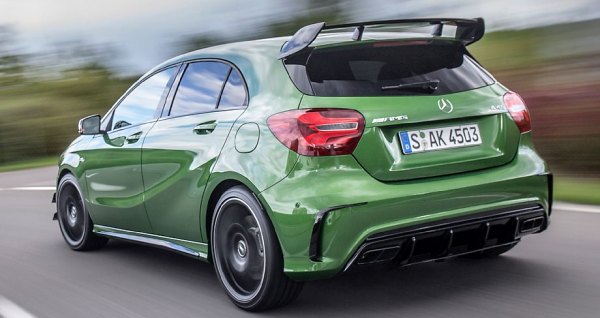
|
Although the M133 engine is already at very high state of tune, AMG
still finds extra grunt by revising its valve timing, intake, exhaust,
combustion etc. There are no dramatic changes, nor the turbo boost
pressure is altered, but these small modifications contribute to an
extra 21 horsepower and 18 pound-foot of torque. The higher peak power
and torque are delivered at the same revs as before, so you get more
grunt without altering the characteristics of the engine. There might
be a little bit more keenness at low rev, which is probably contributed
by the 7G-DCT’s shorter, closer ratios from 3rd to 7th, but overall the
M133 is still renowned for an explosive mid-range punch. Yes, what a
punch! Now it will do 0-60 mph in just 4 seconds flat! De-restricted,
it could easily trump Honda Civic Type R with 170 mph top speed. This
could be the first hot hatch qualified for the status of supercars.
As before, the most memorable moment of the A45 is when the crazy
engine working on full song. Its 4-wheel-drive traction allows you to
exploit the tremendous punch very effectively. This is improved further
by the optional Dynamic+ package of this update, which adds a
mechanical LSD to the front axle and a 2-stage selectable adaptive
damping system. The former makes cornering at tight corners a little
swifter, while the latter softens the ride a bit in comfort mode. No,
they don’t transform the car’s behavior. You might complain that the
A45 still exhibits too much understeer at the limit compared with the
best in class, or it doesn’t oversteer on throttle like Megane RS. The
ride is still on the firm side compared with many rivals. But the AMG
has its own strengths – superior straight line speed, endless traction
and grip, good looks and classy interior. Its closest rival is Audi
RS3, and it beats that car obviously. That is perhaps the most
important mission of this update.
|
Verdict:     |
|
|
|
|
|
|
|
|
|
|
A200
|
2012
|
| Front-engined,
FWD |
| Steel monocoque |
| Mainly steel |
| 4292 / 1780 / 1433 mm |
| 2699 mm |
Inline-4
|
| 1595 cc |
DOHC 16 valves, VVT, VVL
|
| Turbo |
| DI |
156 hp
|
| 184 lbft |
7-speed twin-clutch
|
F: strut
R: multi-link
|
| - |
| 205/55R16 |
1320 kg
|
| 139 mph (c) |
7.9 (c)
|
| - |
|
A200CDI
|
2012
|
| Front-engined,
FWD |
| Steel monocoque |
| Mainly steel |
| 4292 / 1780 / 1433 mm |
| 2699 mm |
Inline-4, diesel
|
| 1796 cc |
DOHC 16 valves
|
| VTG turbo |
| CDI |
136 hp
|
| 221 lbft |
7-speed twin-clutch
|
F: strut
R: multi-link
|
| - |
| 205/55R16 |
1430 kg
|
| 130 mph (c) |
8.7 (c) / 8.9*
|
| 28.3* |
|
A250
|
2012
|
| Front-engined,
FWD |
| Steel monocoque |
| Mainly steel |
| 4292 / 1780 / 1433 mm |
| 2699 mm |
Inline-4
|
| 1991 cc |
DOHC 16 valves, DVVT
|
| Turbo |
| DI |
211 hp
|
| 258 lbft |
7-speed twin-clutch
|
F: strut
R: multi-link
|
| - |
| 235/40R18 |
1370 kg
|
| 149 mph (c) |
6.3 (c)
|
| - |
|
|
|
|
|
Performance
tested by: *Autocar
|
|
|
|
|
|
|
A45
AMG
|
2013
|
| Front-engined,
4WD |
| Steel monocoque |
| Mainly steel |
| 4359 / 1780 / 1417 mm |
| 2699 mm |
Inline-4
|
| 1991 cc |
DOHC 16 valves, DVVT
|
| Turbo |
| DI |
360 hp / 6000 rpm
|
332 lbft / 2250-5000 rpm
|
7-speed twin-clutch
|
F: strut
R: multi-link
|
| - |
| 235/40ZR18 |
1480 kg
|
| 155 mph (limited) |
4.4 (c) / 4.2* / 4.2**
|
11.5* / 10.2**
|
|
A45 AMG (381hp)
|
2015
|
| Front-engined,
4WD |
| Steel monocoque |
| Mainly steel |
| 4367 / 1780 / 1417 mm |
| 2699 mm |
Inline-4
|
| 1991 cc |
DOHC 16 valves, DVVT
|
| Turbo |
| DI |
381 hp / 6000 rpm
|
350 lbft / 2250-5000 rpm
|
7-speed twin-clutch
|
F: strut
R: multi-link
|
Adaptive damping
|
| 235/40ZR18 |
1480 kg
|
| 155 mph (limited) |
4.0 (c)
|
-
|
|
|
|
|
|
|
Performance tested by: *Autocar, **Auto
Zeitung
|
|
|
|
|
|
|
|
|
Copyright©
1997-2015
by Mark Wan @ AutoZine
|
|